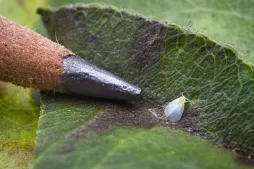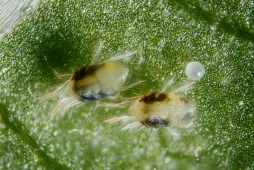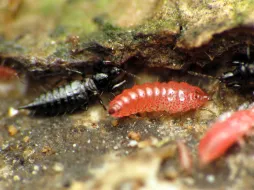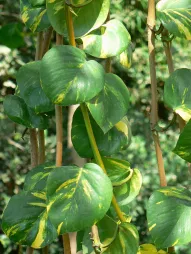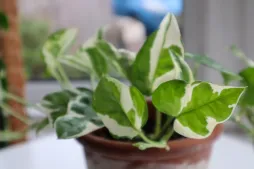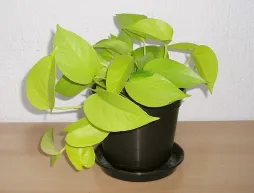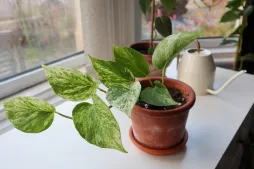Pothos Manjula, small in size and large in variety
In India, near Mumbai, there's a place that all Araceae lovers dream of visiting: a greenhouse where new varieties of pothos are imagined and cultivated. This is where Pothos Manjula (Epipremnum aureum Manjula) was born in 2014. The fruit of several years' research, this cultivar was developed for its compact habit and colorful evergreen foliage.
How to recognize Pothos Manjula?
Pothos Manjula has a compact, semi-receding habit. Its vines, which can reach up to two meters, can be grown hanging or climbing along a stake.
Alternate leaves grow along the stem, with an internode that never exceeds 2.5 centimetres. Oval and pointed at the tip, they resemble an upside-down heart. Each blade displays several shades of green, from darkest to lightest to yellow-green. There's no monochrome block here. Everything is speckled and mottled.
Can't tell the difference between a Pothos Manjula and a Pothos 'N'Joy? Measure the leaves. Those of Pothos Manjula are larger (8.5 centimetres long by 6.5 centimetres wide) than those of its cousin.
Like many cultivars, Pothos Manjula produces neither flowers nor fruit.
Science has modified the plant's appearance, but not its toxicity. Pothos Manjula, like pothos 'Neon, is harmful to humans and animals. It causes skin irritation and digestive disorders.
Our maintenance tips
Pothos 'Manjula are not difficult to care for. Regular watering, a little moisture, a pot optimized for drainage and a little fertilizer are all that's needed.
Watering
Keep the soil slightly moist. Water only when the substrate is dry on the surface, for one or two centimeters.
Water with non-calcareous water at room temperature, without soaking the soil.
Thirty minutes after watering, empty any stagnant water from the cup. This will keep the roots dry and prevent them from rotting.
Spray
Spray foliage with non-calcareous water at room temperature. Fogging helps improve humidity, clean leaves and control pests.
Repotting
Every spring, repot your Epipremnum aureum 'Manjula' to give it more space.
Repot your Pothos 'Manjula in a pot one size larger than the previous one.
If you've decided to give your plant a climbing habit, install your stake now.
Pour in a bed of clay balls or gravel for drainage and a layer of potting soil for houseplants. Plant your Pothos 'Manjula in the center and add substrate. You can guide the stems along the stake to structure the shape of your plant.
Tamp to remove air bubbles.
If your indoor air is dry, place the pot on a saucer of moist clay balls. Water evaporation improves humidity.
Fertilization
To promote the growth of your Epipremnum aureum 'Manjula', apply fertilizer in spring and summer.
Apply green plant fertilizer in addition to watering.
Cleaning
Dust on the leaves slows down photosynthesis and hinders your plant's growth. Clean foliage with a clean, damp sponge. This operation also helps prevent invasions by mites and other pests.
Pinch
Pinch your Epipremnum aureum 'Manjula' during its growing season.
There may be several reasons why you want to deadhead your Epipremnum aureum 'Manjula': to contain its growth, to multiply the plant or to stimulate its development.
Use your fingers or sharp, disinfected secateurs to cut between two knots.
Wear gloves when handling your plant.
Wear gloves when handling your plant.
Cutting
Cutting is carried out during the strong growth phase, generally in spring and early summer.
Cut a stem at least ten centimeters long using sharp, clean pruning shears.
Remove the flowers and leaves at the base, keeping only those at the tip.
Remove the flowers and leaves at the base, keeping only those at the tip.
Immerse your stem in a glass of water at room temperature. Place the cutting in a sunny, draught-free spot. Remember to change the water to keep it clear.
When the roots are at least three centimetres long, you can repot your young shoot.
Diseases / Threats
Information
| Family | Araceae - Araceae |
| Type | Epipremnum - Epipremnum |
| Species | Epipremnum aureum - Epipremnum aureum |
| Lifecycle | Perennial |
| Foliage | Evergreen |
| Exposures | |
| Substrats | |
| Planting method |
In pots |
| Categories | |
| Tags |
Beginner Small pot Toxic |
| Origin |
Southeast Asia |
| Hardiness (USDA) | 11a |
| Leaf color |
|
Discover plants from the same family











